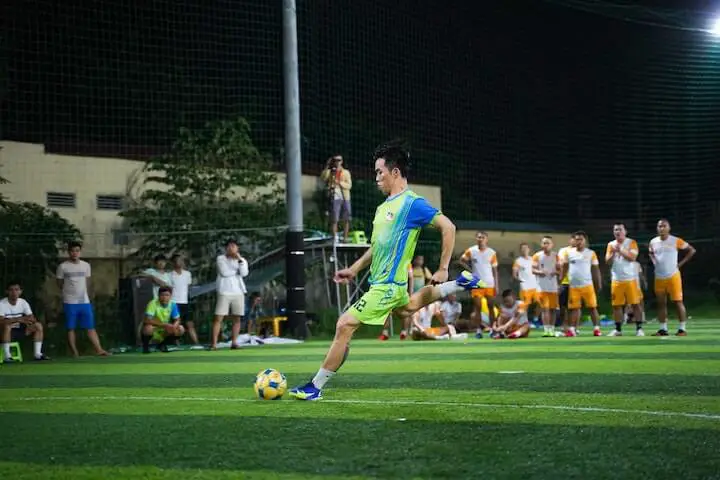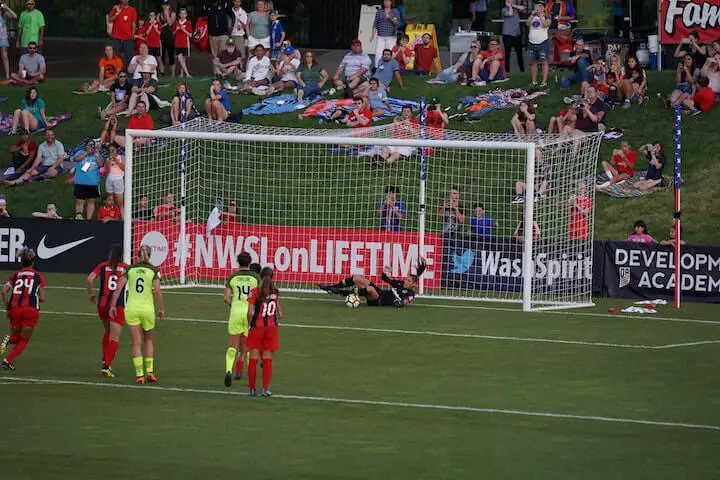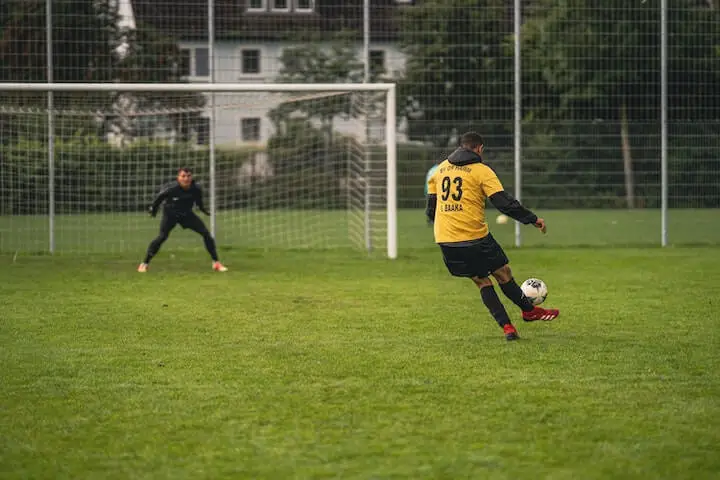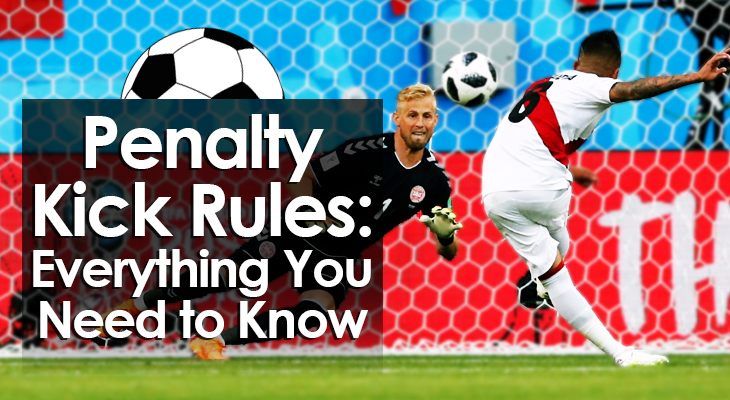Penalty Kick Rules: Everything You Need to Know
Penalty kicks provide some of the most exciting and dramatic moments in soccer.
This 1-v-1 spot kick from 12 yards between the kicker and the goalkeeper seems a relatively straightforward task for professionals.
But considering the pressure of the moment and the quality of goalkeepers, penalty kicks are more difficult to convert than you might think.
(It’s estimated that players only score 75% of penalties!)
Since the introduction of video assistant referee (VAR) technology, penalty kick rules have been subject to frequent change.
Whether you’re a player, coach, or fan, it’s important to fully understand all penalty kick rules.
This article breaks down the important aspects of the penalty kick, ensuring you know exactly what a penalty is, how it should take place, and what fouls result in a penalty.
What is a Penalty Kick?
A penalty kick is a direct free kick taken inside the penalty box, 12 yards from the goal.
Each penalty box has a designated spot that must be clearly marked for penalties.
The main difference between a penalty and a direct free kick is that a penalty is essentially a 1-v-1 shot between the kicker and the goalkeeper.
Until the ball has left the shooter’s foot, no other outfield player may enter the box.
Referees call a penalty when a player commits a foul inside their own penalty area.
The type of foul that results in a penalty is the same as any other direct free kick foul, which we’ll get into a little bit later.
Penalty shootouts are also used as tie-breakers in knockout games or cup competitions, providing some of the most exhilarating, high-pressure moments in the sport.

Penalty Kick Rules and Procedures
There are very specific penalty kick rules that apply to all 11-a-side soccer games.
The kicker, goalkeeper, and all other players operate under different rules during a penalty.
If any player breaks these rules, the kick may have to be retaken.
Penalty Box
Referees award penalty kicks when a player concedes a foul inside their own penalty box.
There are two penalty areas of a field: one on either end. In addition to being penalty zones, the box is also the only area in which goalkeepers can handle the ball.
On a full-size field, the penalty box should measure approximately 44 yards wide, with the goalposts in the center. The box should also be 18 yards long.
There is a small semi-circle on the edge of the box that players cannot enter during a penalty kick.
The radius of this arc is 10 yards from the penalty spot, ensuring players stay a minimum of 10 yards away during a spot kick.
Penalty Spot
The penalty spot is a small circular mark identifying exactly where a player must take the penalty.
All penalty spots must be 12 yards from the very center of the goal frame.
The spot should be white, just like the rest of the field markings.
Goalkeeper’s Role
For the defending team, the only player allowed inside the penalty box during a penalty kick is the goalkeeper.
There are a few rules involving the goalkeeper during penalties, and these have been changed a few times over the years.
As of January 2023, goalkeepers may move along the goal line before the kick is taken but they cannot interfere with the goal frame (crossbar and posts) or the net.
When the opposing player takes the kick, the goalie must have at least some part of one foot either touching, in line with, or behind the goal line.
In the past, ‘keepers were allowed to come off their goal line significantly, making the goal appear much smaller and narrowing shooting angles for kickers.
However, the rules of the game today allow them to spring forward off their line only after the kicker connects with the ball.

Kicker’s Role
After the referee awards the penalty, the designated kicker must be clearly identified.
The kicker can place the ball on the spot in whatever position they like.
Some players opt to face the ball in a certain direction, helping them zone in on a specific area to strike the ball. Others have a specific routine but don’t pay too much attention to ball placement.
Once the ball is in place and the player is ready to take the penalty, the referee blows the whistle.
If a player shoots BEFORE the whistle, they will have to retake the penalty.
The rules allow the kicker to make slight dummies in their run-up to try to outwit the goalie. However, when they reach their final stride, the kick must be in one fluid motion.
While the vast majority of penalties are direct shots on goal, technically they don’t have to be.
The primary rule regarding the strike is that the ball must travel forward. So, in theory, the kicker can pass the ball forward for another teammate to sprint onto from outside the box. This is generally a high-risk tactic though, and is extremely rare to see.
When the kicker makes contact with the ball, the referee deems the penalty as taken. This instance signals the goalkeeper to spring off their goal line and other players to enter the box.
The kicker may NOT touch the ball again after taking the penalty until another player gets a touch or the ball goes out of play.
Therefore, if the ball hits the crossbar or post and comes back into play, the penalty taker can’t score a rebound unless another player gets a touch first.
Other Player Roles
Aside from the goalkeeper and penalty taker, all other players must remain outside the penalty box and its semicircle until the kicker makes contact with the ball.
A missed penalty causes this flooding of players into the box which creates chaos, often resulting in a rebound goal or a scoring chance.
That said, it’s vital for defenders to get into a position from which they can clear the ball if the kicker misses the penalty.
What Happens When Players Break the Rules?
Sanctions for breaking penalty rules vary, depending on the circumstances and players at fault.
As a rule of thumb, think of it this way:
If the team taking the penalty breaks the rules and scores, the penalty is usually retaken. However, if they break the rules and miss, the play usually continues.
If the defending team breaks the rules and the penalty is scored, the goal usually stands. But, if the defending team infringes and the kicker misses, it is likely to be retaken.
In some cases, like when both the kicker and defender foul, the penalty doesn’t count and it then changes to an indirect free kick.
When goalkeepers or kickers break the rules multiple times, they often receive yellow cards from the referee. But one mistake is rarely punished with a card.
When is a Penalty Kick Given?
According to penalty kick rules, teams get a spot kick when a player commits a direct free kick offense inside their own penalty area.
The most common direct free kick offenses include:
- Handball
- Tackling carelessly, recklessly, or with excessive force
- Charging or jumping at an opponent aggressively
- Kicking or attempting to kick an opponent
- Pulling or holding an opponent’s shit
- Pushing an opponent
- Striking or attempting to strike an opponent (e.g. punching, slapping, or head-butting)
Impeding an opponent’s movement with contact
- Biting or spitting at an opponent
- Throwing an object at the ball, an opponent, or a match official

Penalty Shootouts
There’s no more exciting way to decide a close game than a penalty shootout.
Although luck has its part to play in any shootout...
...skill, technique, and execution are the main influences.
Countless times we’ve seen some of the world’s best players let the occasion get to them and take awful penalties in high-stakes shootouts.
If you’re unfamiliar with shootouts and how they work, here’s an overview of the format:
Before the Shootout
When a game is tied at the final whistle (usually after extra time), regulation play is over and players must gather for penalties.
Penalty shootouts are a contest for the best of five penalty kicks.
Before starting, the captains, along with the referee, determine who goes first (statistically, the team who shoots first usually wins) with a coin toss.
There is usually a second coin toss to decide what end the shootout takes place at (it can be a major advantage to have your supporters behind the goal).
All players eligible to shoot take their places at the halfway line and around the center circle, apart from the goalkeepers.
Goalkeepers stay next to the goal for the duration.
The Shootout
Each team takes a penalty each, one after the other, until there is a best-of-five winner.
This is the reason why some shootouts end even before each team has taken five kicks each.
Players can only take a single penalty until the entire squad has taken a kick each (including the goalkeepers). At that point, the order resets and players take a second (this rarely happens).
Only players who were on the field at the final whistle can take a penalty -- substitutes are not eligible.
Unlike in a game, players cannot score a rebound during the shootout -- it’s one kick only.
If teams are level after five penalties, the shootout goes to sudden death.
Since shootouts are essentially tiebreakers, goals do not count toward the final score and players cannot claim a converted penalty as a goal.
Conclusion
Spot kicks are a fundamental and often game-deciding feature of a soccer match so knowing all penalty kick rules is extremely important.
Penalties have been around since the birth of the game and became a staple in the late 1800s.
Bringing ecstasy and agony in equal parts, penalties are going nowhere so make sure to keep up to date with the latest rule changes in your local league or on the IFAB website.

